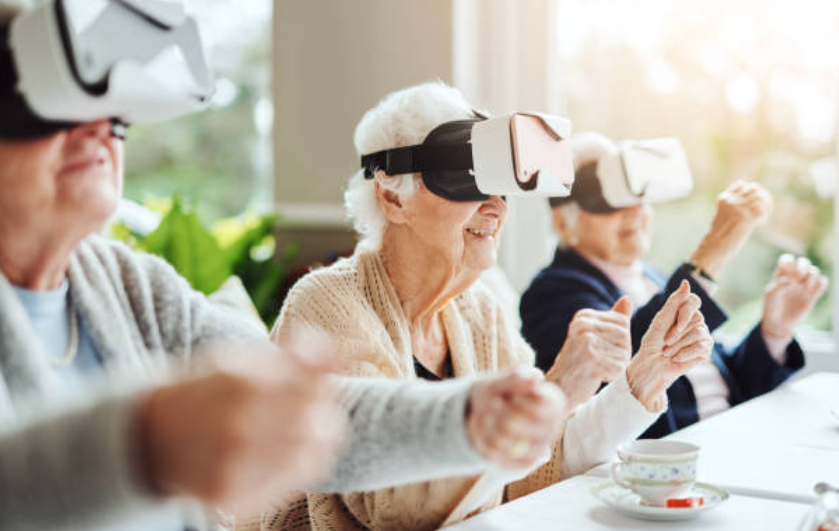
Every single day, 273 Australians over 65 are rushed to hospital because of a fall. That's more than one person every five minutes, making falls the leading cause of injury-related hospitalisation and death among older Australians. But what if the solution to this growing crisis could be found in the high-tech world of virtual reality?
Researchers are discovering that VR technology - once the domain of gamers and tech enthusiasts - might hold the key to preventing falls before they happen, particularly by tackling one of the most overlooked aspects of fall risk: the fear of falling itself.
In this article
The hidden epidemic affecting millions
Falls are the most common cause of hospitalised injury and injury death among people aged 65 and over in Australia, making up 77 per cent of all injury hospitalisations and 71 per cent of injury deaths in this age group. But the statistics only tell part of the story.
Around 30 per cent of adults over 65 experience at least one fall per year, yet there's an even more widespread problem that often goes unnoticed: the fear of falling. Recent research reveals that fall-related anxiety affects 40-73 per cent of those who have fallen and 20-39 per cent of older adults overall, though some studies suggest it can affect over 85 per cent of older adults.
Dr Tiphanie Raffegeau from George Mason University, who is leading groundbreaking research into VR fall prevention, puts it starkly: 'Up to 85 per cent of older adults have fear of falling.'
'The emotion was just overwhelming for my carers … I have seen a much more empathetic group of people'
This fear creates a vicious cycle. Falls can result in restriction of activity and fear of falling, reduced quality of life and independence. Even falls that do not result in physical injuries can result in the 'post-fall syndrome' - a loss of confidence, hesitancy, tentativeness with resultant loss of mobility and independence. After falling, 48 per cent of older people report a fear of falling and 25 per cent report curtailing activities.
The Real Cost of Falls in Australia
Forty-one per cent ($4.3 billion) of Australia's injury treatment spending goes on treating injuries due to falls, equivalent to $153 per capita, with costs expected to rise to around $1.4 billion by 2051.
When technology meets healthcare innovation
Enter virtual reality - technology that's proving surprisingly effective at addressing both the physical and psychological aspects of fall prevention. Unlike traditional balance training, VR can create controlled environments where older adults can safely experience challenging situations and gradually build confidence.
Recent research has found that experiencing fall-related anxiety in immersive VR can initially impair a senior's walking performance, but interestingly, the anxiety response tapers over time, suggesting that experiencing virtual high-elevation settings may reduce fall-related anxiety overall. This suggests the VR experience could serve as a clinical intervention to improve walking.
The technology works by simulating real-world scenarios that might trigger anxiety - walking on uneven surfaces, navigating stairs, or dealing with busy environments - all while the user remains safely seated or standing in a controlled space.
Breaking down the cost barrier
One of the biggest barriers to VR adoption has been cost, but prices have dropped dramatically. The Meta Quest 2 used to cost $479 for the 128GB Standard Edition, though that price has since increased to $629.99. However, the Meta Quest 3S has brought incredible mixed-reality features and great VR gaming specs to an affordable price range, starting at $299, making it the cheapest device worth buying.
For aged care facilities operating on tight budgets, there are even more affordable options. Smartphone VR headsets cost between $20 and $100 on Amazon and eBay, with the VR Box 2.0 available for around $30.
Australian success stories: VR already making a difference
Far from being a futuristic concept, VR is already being used successfully in Australian aged care facilities. SilVR Adventures, an Australian company specialising in VR for seniors, has seen remarkable results. Over a 12-month pilot program across multiple sites with UnitingCare Queensland, 85 per cent of customers said that VR sessions as therapy helped to significantly drive social engagements, 89 per cent of residents said they would like to use VR again, and 91 per cent would recommend it to their friends.
Dementia care breakthrough
Australia is also leading the world in using VR for dementia care training. Dementia Australia is a leading provider in VR based dementia training in Australia and internationally, reshaping professional dementia care in Australia with award-winning experiential learning.
Their programs, including EDIE (Enabling Dementia Interactive Experience) and D-Esc (de-escalation training), use VR to help care workers understand the world from a person with dementia's perspective. Staff become immersed in VR training programs to gain understanding and skills in being person-centred, navigating changed behaviours, enhancing communication, creating enabling environments, and de-escalating challenging situations.
VR Implementation Success Factors
- Start with affordable smartphone-based VR systems ($30-100)
- Ensure proper staff training and support
- Focus on gradual exposure to build confidence
- Combine with traditional therapy approaches
- Track progress and outcomes for residents
The research behind the technology
The science supporting VR fall prevention is becoming increasingly solid. Virtual reality interventions can effectively improve gait and dynamic and static balance function, enhance lower limb muscle strength, and reduce the risk of falls in non-disabled elderly individuals.
A comprehensive study of older adults using VR fall prevention programs found multiple benefits. The benefits were related not only to balance but also to fear of falling, reaction time, gait, physical fitness, independence in activities of daily living, muscle strength, and even quality of life.
However, researchers are honest about the limitations. The effect of virtual reality on reducing the fear of falling remains controversial. More research is needed to understand exactly how and when VR is most effective.
The George Mason breakthrough
The research by Dr Raffegeau and her team at George Mason University, awarded a 4-VA grant for the project, represents one of the most promising developments in the field. Their work focuses specifically on what they call 'fear of falling' - the psychological barrier that can be just as limiting as physical impairments.
The research team hired three student programmers from George Mason's Virginia Serious Game Institute (VSGI) to help, supervised by VSGI research faculty member Jacob Enfield, with two graduate students also working on the project.
Practical implementation: Making VR work in aged care
The key to successful VR implementation isn't just buying the equipment - it's about proper integration into existing care programs. Providing time and resources for a VR champion to experiment and learn about the technology is critical. The development of an online implementation toolkit provides aged care stakeholders with evidence-based resources needed to ensure successful implementation of VR-based leisure programs.
Australian aged care facilities implementing VR programs have found several critical success factors:
Staff training is essential: Using immersive VR headsets, programs expose participants to common symptoms of dementia, such as impaired vision, hearing, and balance issues. The VR experience gives staff the opportunity to be on the other side of a care interaction, though it can be a very confronting experience and is carefully monitored.
Start small and build up: Rather than implementing facility-wide programs immediately, successful implementations begin with pilot programs and gradually expand based on results and staff confidence.
Did you know?
Did You Know?
In Australian residential aged care in 2022, 37 per cent of people required high care in activities of daily living, cognition and behaviour, and complex health care. COVID-19 has added impetus to pursuing 'healthy ageing' and one strategy that has been trialled in residential aged care is virtual reality.
Overcoming the challenges
Like any new technology in healthcare, VR faces implementation challenges. The application of VR technology faces many challenges and is not easily manageable under COVID-19 restrictions and the limitation on technological adaptation for older adults. However, investment in full immersive VR technology application is supported for future adoption in aged care and rehabilitation services.
The most common concerns include:
- Technology anxiety: Some older adults may feel intimidated by VR headsets initially
- Physical limitations: Vision problems or balance issues may limit some participants
- Staff training requirements: Care workers need proper training to effectively support VR programs
- Cost considerations: While prices have dropped, quality VR systems still represent a significant investment for many facilities
The future of fall prevention
The potential for VR in fall prevention extends well beyond the current applications. Research is exploring:
- Personalised risk assessment: Using VR to identify individual fall risk factors in safe environments
- Home-based interventions: Developing VR programs that older adults can use independently at home
- Integration with other technologies: Combining VR with wearable sensors to provide real-time feedback
- Cognitive training: Using VR to improve the mental processes involved in balance and coordination
Real-world training is expensive while VR is technically low-cost. Simulations also allow total control of the environment, which is much safer.
Where to from here?
The evidence is clear that VR has significant potential to address Australia's growing fall prevention challenge. With the proportion of people aged over 65 predicted to increase from 14 per cent (3 million people) in 2010 to 23 per cent (8.1 million people) in 2050, the need for innovative, cost-effective interventions has never been greater.
For families considering aged care options, it's worth asking potential providers about their approach to fall prevention and whether they use or plan to implement VR programs. For aged care facilities, the technology is now accessible enough to begin pilot programs without major capital investment.
What This Means For You
The beauty of VR fall prevention lies not just in its technological sophistication, but in its ability to address the human element - the fear and anxiety that can be just as debilitating as physical impairments. By giving older adults the confidence to move freely and safely, VR doesn't just prevent falls - it helps preserve the independence and quality of life that matter most.
What's your experience with fall prevention programs? Have you or a loved one encountered VR technology in aged care settings? Share your thoughts and experiences - your insights could help others navigate this important aspect of healthy ageing.
Falls in older Australians 2019–20: hospitalisations and deaths among people aged 65 and over, Impact of falls among older Australians - Australian Institute of Health and Welfare
Falls are the most common cause of hospitalised injury and injury death among people aged 65 and over in Australia.
https://www.aihw.gov.au/reports/inj...tents/impact-of-falls-among-older-australians
Falls in older Australians 2019–20: hospitalisations and deaths among people aged 65 and over, Summary - Australian Institute of Health and Welfare
Falls is the leading cause of hospitalised injuries and injury deaths among older Australians, making up 77 per cent of all injury hospitalisations and 71 per cent of...
https://www.aihw.gov.au/reports/inj...ians-2019-20-hospitalisation/contents/summary
Info about falls | Australia and New Zealand Falls Prevention Society
The problem and prevalence of falls · Falls are a major health issue in the community with around 30 per cent of adults over 65 experiencing at least one fall...
https://www.anzfallsprevention.org/info/
Info about falls | Australia and New Zealand Falls Prevention Society
Falls are a major health issue in the community with around 30 per cent of adults over 65 experiencing at least one fall per year.
https://www.anzfallsprevention.org/info/
A systematic review on the influence of fear of falling on quality of life in older people: is there a role for falls? - PMC
Maintaining or improving quality of life (QoL) is a key outcome of clinical interventions in older people. Fear of falling (FoF) is associated with ac...
https://pmc.ncbi.nlm.nih.gov/articles/PMC6514257/
A concept analysis of fear of falling in older adults: insights from qualitative research studies | BMC Geriatrics | Full Text
Recently, it has been argued that fear of falling doesn’t simply mean a state of low falls efficacy, but is a concept distinct from falls efficacy.
https://bmcgeriatr.biomedcentral.com/articles/10.1186/s12877-023-04364-5
Info about falls | Australia and New Zealand Falls Prevention Society
Falls can also result in restriction of activity and fear of falling, reduced quality of life and independence. Even falls that do not result in physi...
https://www.anzfallsprevention.org/info/
Falls in older Australians 2019–20: hospitalisations and deaths among people aged 65 and over, Impact of falls among older Australians - Australian Institute of Health and Welfare
Forty-one per cent ($4.3 billion) of this was spent on treating injuries due to falls, equivalent to $153 per capita (AIHW 2021d), with the amount spent ...
https://www.aihw.gov.au/reports/inj...tents/impact-of-falls-among-older-australians
Info about falls | Australia and New Zealand Falls Prevention Society
With a stable incidence rate the cost of falls is expected to rise to around $1.4 billion by 2051.
https://www.anzfallsprevention.org/info/
A concept analysis of fear of falling in older adults: insights from qualitative research studies | BMC Geriatrics | Full Text
Therefore, it is necessary to understand the unique characteristics of the fear of falling. This study aims to analyse the concept of ‘fear of falling...
https://bmcgeriatr.biomedcentral.com/articles/10.1186/s12877-023-04364-5
A concept analysis of fear of falling in older adults: insights from qualitative research studies | BMC Geriatrics | Full Text
A concept analysis was conducted by Walker & Avant’s eight-step concept analysis method.
https://bmcgeriatr.biomedcentral.com/articles/10.1186/s12877-023-04364-5
Best Budget VR Headset: Top Affordable Picks for 2025
Below are my findings. Pimax Crystal Light – best budget VR headset overall · Meta Quest 3S – best budget-friendly standalone VR headset ...
https://cybernews.com/vr-ar/best-budget-vr-headset/
VIVE Australia | Discover Virtual Reality Beyond Imagination
Best Budget VR Headset: Top Affordable Picks for 2025
Price vs. features: If you're wondering how much a VR headset costs and whether it offers the features you want, you should know that budget VR headse...
https://cybernews.com/vr-ar/best-budget-vr-headset/
Best Budget VR Headset: Top Affordable Picks for 2025
With the assistance of Cybernews researchers, I first analysed manufacturer spec sheets to create a list of the best budget VR headsets.
https://cybernews.com/vr-ar/best-budget-vr-headset/
Homepage - Aged Care Virtual Reality
It’s been great to give people the chance to experience Iceland, Hot Air Ballooning, a Helicopter flight and return home to Italy all in one day, and ...
https://www.agedcarevirtualreality.com/
VR training set to transform dementia education - Inside Ageing
The primary goal is to reduce the use of restrictive practices and mitigate the severity and frequency of dangerous incidents in care environments. In...
https://insideageing.com.au/vr-training-set-to-transform-dementia-education/
VR training set to transform dementia education - Inside Ageing
Dementia Australia has unveiled D-Esc, a cutting-edge virtual reality (VR) training workshop designed to revolutionise de-escalation techniques in dem...
https://insideageing.com.au/vr-training-set-to-transform-dementia-education/
VR training set to transform dementia education - Inside Ageing
Inside Ageing acknowledges the Australian First Nations people as the nation's first inhabitants and the traditional custodians of the lands where we ...
https://insideageing.com.au/vr-training-set-to-transform-dementia-education/
The association between fear of falling and occurrence of falls: a one-year cohort study | BMC Geriatrics | Full Text
After a year of following-up, the number of falls during the year was considered as the main outcome.
https://bmcgeriatr.biomedcentral.com/articles/10.1186/s12877-022-03018-2
The association between fear of falling and occurrence of falls: a one-year cohort study | BMC Geriatrics | Full Text
The mean of number of fall incidents during the one-year follow-up according to self-reported fall history and FoF at the baseline measurement FoF: fe...
https://bmcgeriatr.biomedcentral.com/articles/10.1186/s12877-022-03018-2
How fear of falling can impact older adults’ physical, mental health
As Falls Prevention Week approaches, Auburn University faculty Razan Al Fakir provides expertise about fall-related anxiety, which is pervasive among ...
https://wire.auburn.edu/content/ocm/2024/09/201104-fear-of-falling-ea.php
The association between fear of falling and occurrence of falls: a one-year cohort study | BMC Geriatrics | Full Text
Poisson regression models clarified the influence of FoF on fall occurrence during the one-year follow-up, according to the participants’ fall history...
https://bmcgeriatr.biomedcentral.com/articles/10.1186/s12877-022-03018-2
A concept analysis of fear of falling in older adults: insights from qualitative research studies | BMC Geriatrics | Full Text
Background Fear of falling is a persistent concern about falls that commonly occur in older adults.
https://bmcgeriatr.biomedcentral.com/articles/10.1186/s12877-023-04364-5
A concept analysis of fear of falling in older adults: insights from qualitative research studies | BMC Geriatrics | Full Text
Therefore, it is necessary to understand the unique characteristics of the fear of falling.
https://bmcgeriatr.biomedcentral.com/articles/10.1186/s12877-023-04364-5
A concept analysis of fear of falling in older adults: insights from qualitative research studies | BMC Geriatrics | Full Text
Fear of falling is a persistent concern about falls that commonly occur in older adults. Recently, it has been argued that fear of falling doesn’t sim...
https://bmcgeriatr.biomedcentral.com/articles/10.1186/s12877-023-04364-5
Immersive virtual reality in the promotion of health and well-being for people in residential aged care without cognitive impairment: A scoping review - PMC
This article is distributed under the terms of the Creative Commons Attribution-NonCommercial 4.0 License (https://creativecommons.org/licenses/by-nc/...
https://pmc.ncbi.nlm.nih.gov/articles/PMC11055491/
Christopher Rhea - Associate Dean for Research & ...
Access knowledge, insights and opportunities.
https://www.linkedin.com/in/christopher-rhea-76837083
Effectiveness of virtual reality in preventing falls in non-disabled older adults: A meta-analysis and systematic review - ScienceDirect
44-51 ... Geriatric Nursing, Volume 58, 2024, pp. 59-68 ... Geriatric Nursing, Volume 58, 2024, pp. 127-134 ... Geriatric Nursing, Volume 58, 2024, pp...
https://www.sciencedirect.com/science/article/abs/pii/S0197457224000764
Transforming aged care with virtual reality: How organisational culture impacts technology adoption and sustained uptake - PubMed
4 QUT Design Lab, Australia School of Architecture and Built Environment, Queensland University of Technology, Brisbane, Queensland, Australia. 5 Soci...
https://pubmed.ncbi.nlm.nih.gov/37803886/
Using virtual reality to prevent falls in older adults | George Mason University
They saw an opportunity to develop effective uses of VR technology to detect cognitive-motor function in older adults and identify fall-risk factors f...
https://www.gmu.edu/news/2025-07/using-virtual-reality-prevent-falls-older-adults
Info about falls | Australia and New Zealand Falls Prevention Society
This is set to increase as Australia’s population ages with the proportion of people aged over 65 predicted to increase from 14 per cent (3 million people) in...
https://www.anzfallsprevention.org/info/







